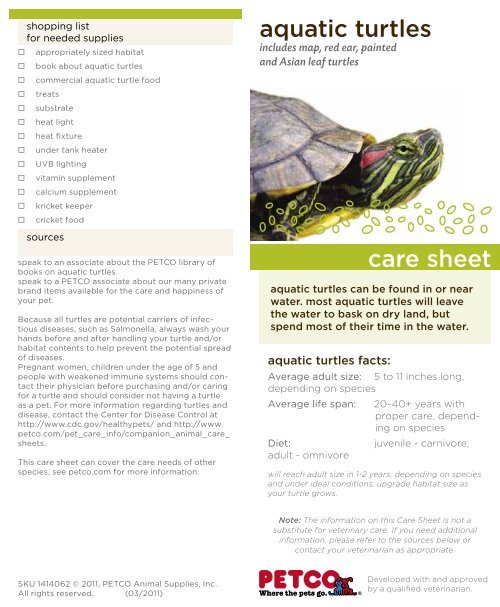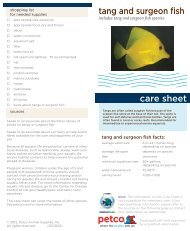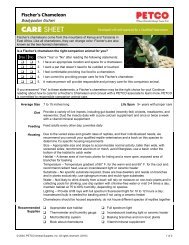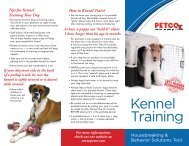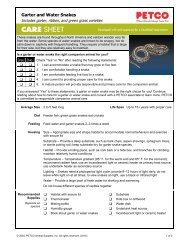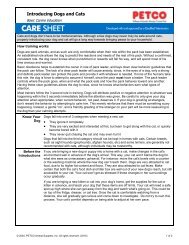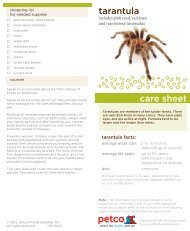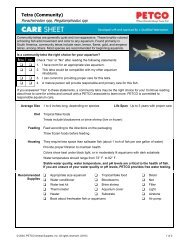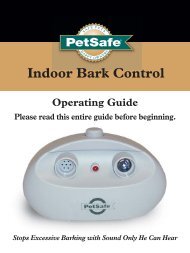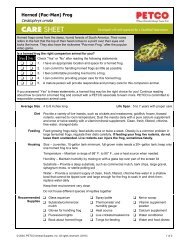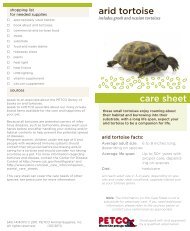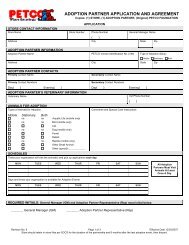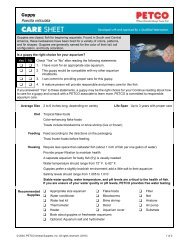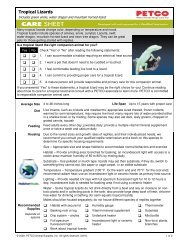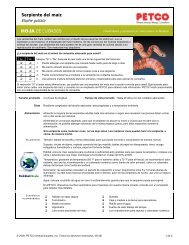Aquatic Turtle - Petco
Aquatic Turtle - Petco
Aquatic Turtle - Petco
Create successful ePaper yourself
Turn your PDF publications into a flip-book with our unique Google optimized e-Paper software.
shopping list<br />
for needed supplies<br />
<br />
appropriately sized habitat<br />
<br />
book about aquatic turtles<br />
<br />
commercial aquatic turtle food<br />
<br />
<br />
<br />
<br />
<br />
<br />
<br />
<br />
<br />
<br />
treats<br />
substrate<br />
heat light<br />
heat fixture<br />
under tank heater<br />
UVB lighting<br />
vitamin supplement<br />
calcium supplement<br />
kricket keeper<br />
cricket food<br />
sources<br />
speak to an associate about the PETCO library of<br />
books on aquatic turtles.<br />
speak to a PETCO associate about our many private<br />
brand items available for the care and happiness of<br />
your pet.<br />
Because all turtles are potential carriers of infectious<br />
diseases, such as Salmonella, always wash your<br />
hands before and after handling your turtle and/or<br />
habitat contents to help prevent the potential spread<br />
of diseases.<br />
Pregnant women, children under the age of 5 and<br />
people with weakened immune systems should contact<br />
their physician before purchasing and/or caring<br />
for a turtle and should consider not having a turtle<br />
as a pet. For more information regarding turtles and<br />
disease, contact the Center for Disease Control at<br />
http://www.cdc.gov/healthypets/ and http://www.<br />
petco.com/pet_care_info/companion_animal_care_<br />
sheets.<br />
This care sheet can cover the care needs of other<br />
species, see petco.com for more information.<br />
aquatic turtles<br />
includes map, red ear, painted<br />
and Asian leaf turtles<br />
care sheet<br />
aquatic turtles can be found in or near<br />
water. most aquatic turtles will leave<br />
the water to bask on dry land, but<br />
spend most of their time in the water.<br />
aquatic turtles facts:<br />
Average adult size: 5 to 11 inches long,<br />
depending on species<br />
Average life span: 20-40+ years with<br />
proper care, depending<br />
on species<br />
Diet:<br />
juvenile - carnivore;<br />
adult - omnivore<br />
will reach adult size in 1-2 years, depending on species<br />
and under ideal conditions; upgrade habitat size as<br />
your turtle grows.<br />
Note: The information on this Care Sheet is not a<br />
substitute for veterinary care. If you need additional<br />
information, please refer to the sources below or<br />
contact your veterinarian as appropriate.<br />
SKU 1414062 © 2011, PETCO Animal Supplies, Inc.<br />
All rights reserved. (03/2011)<br />
Developed with and approved<br />
by a qualified veterinarian.
care sheet<br />
aquatic turtles<br />
includes map, red ear, painted and<br />
Asian leaf turtles<br />
Developed with and approved<br />
by a qualified veterinarian.<br />
diet<br />
a well-balanced aquatic<br />
turtle diet consists of:<br />
• map & Asian leaf -<br />
live comet goldfish,<br />
earthworms,<br />
mealworms,<br />
bloodworms, snails<br />
and crickets.<br />
• painted wood & red<br />
ear - dark, leafy green<br />
veggies and finely<br />
chopped veggies.<br />
Red ears also benefit<br />
from comet goldfish,<br />
earthworms and<br />
insects as treats.<br />
• these aquatic turtles<br />
need a pelleted<br />
commercial diet.<br />
feeding<br />
things to remember when<br />
feeding your aquatic<br />
turtle:<br />
• fresh, clean, chlorinefree<br />
water should be<br />
available at all times.<br />
• feed juveniles daily,<br />
adults every other day;<br />
need to be fed in water<br />
to eat.<br />
• consider a separate<br />
feeding tank as<br />
aquatic turtles are<br />
messy eaters.<br />
• sprinkle food with<br />
calcium supplement<br />
daily and a multivitamin<br />
supplement<br />
once or twice a week.<br />
housing<br />
• size - appropriate size<br />
habitat, at least a 40<br />
gallon breeder tank<br />
with a screened lid so<br />
the turtle can’t escape.<br />
a good rule of thumb is<br />
10 gallons per inch of<br />
turtle; adult turtles will<br />
require more room.<br />
• habitat - aquatic<br />
turtles drink the water<br />
they swim in, so it<br />
needs to be changed<br />
frequently.<br />
• substrate - slate, rock,<br />
or a large smooth<br />
gravel, too large to eat,<br />
is optional; water for<br />
swimming area; some<br />
aquatic turtles require<br />
a shallow area they can<br />
rest in the water with<br />
their head sticking<br />
out. red ears require<br />
a turtle dock area to<br />
bask out of the water,<br />
other turtles require<br />
dry land areas outside<br />
of the water; create<br />
slopes for easy entry<br />
and exit to water.<br />
• temperature -<br />
temperature gradient<br />
(95°F for the warm<br />
end/basking area and<br />
75°F for the cool end/<br />
water); recommend<br />
radiant heat; use an<br />
incandescent light<br />
or ceramic heater as<br />
primary heat source.<br />
• lighting - UVB rays<br />
with full spectrum<br />
lighting for 10-12 hours<br />
a day is required;<br />
incandescent lighting<br />
is needed for basking<br />
area.<br />
• house adult aquatic<br />
turtles alone and do<br />
not house different<br />
turtle species together.<br />
normal<br />
behavior<br />
turtles do not like frequent<br />
handling and may<br />
bite when frightened.<br />
aquatic turtles are excellent<br />
swimmers.<br />
common health issues<br />
habitat<br />
maintenance<br />
thoroughly clean the<br />
habitat at least once a<br />
week: place turtle in a<br />
secure habitat; scrub<br />
the tank and furnishings<br />
with a 3% bleach solution;<br />
rinse thoroughly<br />
with water, removing all<br />
traces of bleach smell.<br />
Add clean, dechlorinated<br />
water, with a temperature<br />
range from 70-75°F<br />
before returning turtle.<br />
grooming<br />
& hygiene<br />
keep the habitat clean<br />
and remove uneaten<br />
food and feces right<br />
away.<br />
signs of a<br />
healthy animal<br />
• active and alert<br />
• eats regularly<br />
• healthy, hard shell with<br />
no lesions<br />
• clear, bright eyes with<br />
no swelling<br />
• healthy skin with no<br />
sores<br />
• clear nose and vent<br />
red flags<br />
• eye, nose, or mouth<br />
discharge<br />
• discolored, bumps or<br />
spots on shell or skin<br />
• lethargic<br />
• frantic swimming<br />
• abnormal feces<br />
• sneezing, runny nose<br />
If you notice any of these signs, please contact your<br />
exotic animal veterinarian.<br />
Health Issue Symptoms or Causes Suggested Action<br />
GI tract<br />
parasites<br />
respiratory<br />
infection<br />
shell rot/ulcers<br />
eye or<br />
respiratory<br />
infection<br />
poor appetite, listlessness,<br />
possibly diarrhea and anal<br />
prolapse.<br />
open mouth breathing,<br />
eye nose and/or mouth<br />
discharge; sneezing. can be<br />
caused by a cold habitat.<br />
swollen eyes and sides of<br />
head; may be caused by a<br />
vitamin A deficiency.<br />
consult your exotic<br />
animal veterinarian as<br />
soon as possible.<br />
consult your exotic<br />
animal veterinarian<br />
and ensure habitat is<br />
appropriately warm.<br />
consult your exotic<br />
animal veterinarian<br />
and ensure daily<br />
cleanings and/or diet<br />
changes.<br />
consult your exotic<br />
animal veterinarian<br />
and use a vitamin<br />
supplement.


